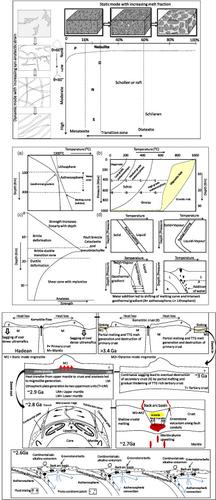当前位置:
X-MOL 学术
›
Geolog. J.
›
论文详情
Our official English website, www.x-mol.net, welcomes your feedback! (Note: you will need to create a separate account there.)
Migmatite rheology of crustal catazone: An example from the SSE part of T. Sundupalle granite-greenstone terrain, Eastern Dharwar Craton, India
Geological Journal ( IF 1.4 ) Pub Date : 2021-04-27 , DOI: 10.1002/gj.4159 Sukanta Goswami 1 , Purnajit Bhattacharjee 2 , Sudhiranjan Swain 1 , Chanchal Sarbajna 1 , R. Muralidharan 1 , Dilip Kumar Choudhury 1 , Dheeraj Pande 2 , Deepak Kumar Sinha 2
Geological Journal ( IF 1.4 ) Pub Date : 2021-04-27 , DOI: 10.1002/gj.4159 Sukanta Goswami 1 , Purnajit Bhattacharjee 2 , Sudhiranjan Swain 1 , Chanchal Sarbajna 1 , R. Muralidharan 1 , Dilip Kumar Choudhury 1 , Dheeraj Pande 2 , Deepak Kumar Sinha 2
Affiliation

|
The southern basement of the Cuddapah Basin comprises the Dharwar Batholith and greenstone belt complex. Granitoids of the batholith exhibit extensive variation in terms of geomorphology, age, mineralogy, and micro/meso scale structures. The eastern part of Dharwar Craton along 13°50′ to 14°8′N latitude and 78°45′ to 79°05′E longitude was studied to enlighten the rheological influence on crustal evolution. Frequent occurrences of migmatites of restricted dimension are observed in the south of 14°10′N latitude. The granite-migmatite contacts are not sharp in general. Different types of migmatite complex and their relationships with granitoids as well as older country rocks represent an exhumed segment of the crustal catazone. The widespread group of migmatitic rocks are classified in a composite manner on the basis of morphology and structure. Furthermore, genetic implication vis-a-vis anatexis history is also evaluated. Static and dynamic modes of migmatites are recognized with reference to geothermal gradient and tectonics. Based on the degree of anatexis, two categories of migmatites are identified in the field, that is, metatexites and diatexites. In addition, metatexites are classified into four sub-types (viz, patch, dilatant, net, and stromatic) and diatexites are also sub-divided into two categories (viz, schollen or raft and schlieren). The hybrid nature of migmatitic rocks with both metamorphic and igneous characteristics are used to analyse pre- and post-anatectic events. The preserved evidences of partial melting are marked as leucocratic patches. In situ stagnation of the melt or subsequent separation from the remaining solid provides different morphology of static mode. Importance of dihedral angle at solid–liquid contacts is also considered in the present context to describe the grain boundary penetration by partial melt. Folds, veins, and boudins of different styles and generations played significant role in dynamic mode migmatitization. The syn- and post-metamorphic deformation events and granite melt generation from migmatites are schematically defined. Spatial and temporal relationships of schist-gneiss-migmatites of both static as well as dynamic mode reveal initiation of the crustal development by vertical accretion of ultramafic-mafic lava and TTG. Cyclic partial remelting of the metabasic lava and TTG and underplating led to development of the lithospheric plate. Later upwelling material at convergent plate and associated heat transfer led to generation of granitic magma. The established prograde and retrograde cycle of metamorphism were possibly interrupted by crustal reworking events. This study confirms about the crustal catazone segment (with >15 km depth and >500°C) in which physical processes control generation, segregation, ascent, and emplacement of juvenile granite from migmatites.
中文翻译:

地壳catazone的混合岩流变学:以印度东达尔瓦尔克拉通T. Sundupalle花岗岩-绿岩地形的SSE部分为例
Cuddapah 盆地的南部地下室包括 Dharwar 基石和绿岩带复合体。基岩的花岗岩在地貌、年龄、矿物学和微/中尺度结构方面表现出广泛的变化。研究了沿北纬13°50′至14°8′和东经78°45′至79°05′的达尔瓦尔克拉通东部,以揭示流变学对地壳演化的影响。在北纬 14°10'N 以南经常观察到尺寸受限的混合岩。花岗岩-混合岩接触面一般不尖锐。不同类型的混合岩复合体及其与花岗岩以及较老的乡土岩石的关系代表了地壳塌陷带的挖掘部分。广泛分布的混合岩群根据形态和结构以复合方式分类。此外,还评估了与 anatexis 历史相关的遗传含义。混合岩的静态和动态模式是根据地温梯度和构造来识别的。根据矿化程度,在该领域确定了两类混合岩,即变质岩和混纺岩。此外,超细织物分为四个亚型(即、斑块、膨胀、网状和间质),而超细织物也细分为两类(即,schollen 或筏状和纹状体)。具有变质和火成岩特征的混合岩的混合性质被用于分析前和后深熔事件。部分熔化的保存证据被标记为白斑。熔体的原位停滞或随后与剩余固体的分离提供了不同的静态模式形态。在本文中还考虑了固液接触处二面角的重要性,以描述部分熔体对晶界的渗透。不同风格和世代的褶皱、脉络和布丁在动态模式混合中发挥了重要作用。示意性地定义了同变质和变质后变形事件以及混合岩的花岗岩熔体生成。静态和动态模式的片岩-片麻岩-混合岩的时空关系揭示了地壳发育是由超基性-基性熔岩和 TTG 的垂直吸积开始的。变基性熔岩和 TTG 的循环部分重熔和底镀导致了岩石圈板块的发育。后来会聚板处的上升流物质和相关的热传递导致了花岗岩岩浆的产生。已建立的变质作用的前进和逆行循环可能被地壳改造事件中断。本研究证实了地壳崩裂带段(深度大于 15 公里且大于 500°C),其中物理过程控制着混合岩中新生花岗岩的生成、分离、上升和就位。
更新日期:2021-04-27
中文翻译:

地壳catazone的混合岩流变学:以印度东达尔瓦尔克拉通T. Sundupalle花岗岩-绿岩地形的SSE部分为例
Cuddapah 盆地的南部地下室包括 Dharwar 基石和绿岩带复合体。基岩的花岗岩在地貌、年龄、矿物学和微/中尺度结构方面表现出广泛的变化。研究了沿北纬13°50′至14°8′和东经78°45′至79°05′的达尔瓦尔克拉通东部,以揭示流变学对地壳演化的影响。在北纬 14°10'N 以南经常观察到尺寸受限的混合岩。花岗岩-混合岩接触面一般不尖锐。不同类型的混合岩复合体及其与花岗岩以及较老的乡土岩石的关系代表了地壳塌陷带的挖掘部分。广泛分布的混合岩群根据形态和结构以复合方式分类。此外,还评估了与 anatexis 历史相关的遗传含义。混合岩的静态和动态模式是根据地温梯度和构造来识别的。根据矿化程度,在该领域确定了两类混合岩,即变质岩和混纺岩。此外,超细织物分为四个亚型(即、斑块、膨胀、网状和间质),而超细织物也细分为两类(即,schollen 或筏状和纹状体)。具有变质和火成岩特征的混合岩的混合性质被用于分析前和后深熔事件。部分熔化的保存证据被标记为白斑。熔体的原位停滞或随后与剩余固体的分离提供了不同的静态模式形态。在本文中还考虑了固液接触处二面角的重要性,以描述部分熔体对晶界的渗透。不同风格和世代的褶皱、脉络和布丁在动态模式混合中发挥了重要作用。示意性地定义了同变质和变质后变形事件以及混合岩的花岗岩熔体生成。静态和动态模式的片岩-片麻岩-混合岩的时空关系揭示了地壳发育是由超基性-基性熔岩和 TTG 的垂直吸积开始的。变基性熔岩和 TTG 的循环部分重熔和底镀导致了岩石圈板块的发育。后来会聚板处的上升流物质和相关的热传递导致了花岗岩岩浆的产生。已建立的变质作用的前进和逆行循环可能被地壳改造事件中断。本研究证实了地壳崩裂带段(深度大于 15 公里且大于 500°C),其中物理过程控制着混合岩中新生花岗岩的生成、分离、上升和就位。
















































 京公网安备 11010802027423号
京公网安备 11010802027423号